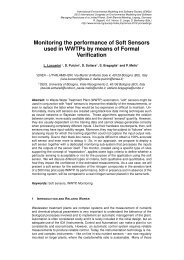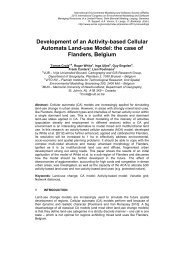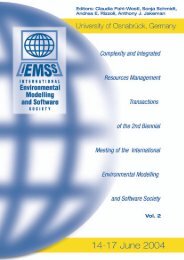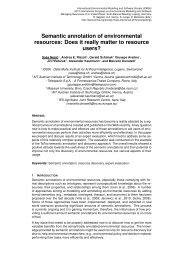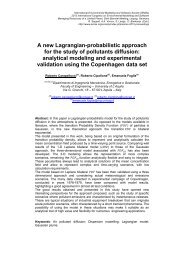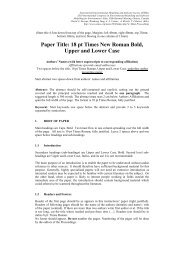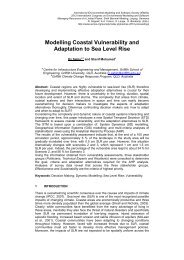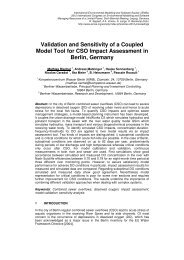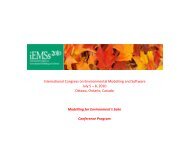Suitability of land cover and remote sensing data for modelling ...
Suitability of land cover and remote sensing data for modelling ...
Suitability of land cover and remote sensing data for modelling ...
You also want an ePaper? Increase the reach of your titles
YUMPU automatically turns print PDFs into web optimized ePapers that Google loves.
International Environmental Modelling <strong>and</strong> S<strong>of</strong>tware Society (iEMSs)<br />
2012 International Congress on Environmental Modelling <strong>and</strong> S<strong>of</strong>tware<br />
Managing Resources <strong>of</strong> a Limited Planet, Sixth Biennial Meeting, Leipzig, Germany<br />
R. Seppelt, A.A. Voinov, S. Lange, D. Bankamp (Eds.)<br />
http://www.iemss.org/society/index.php/iemss-2012-proceedings<br />
<strong>Suitability</strong> <strong>of</strong> <strong>l<strong>and</strong></strong> <strong>cover</strong> <strong>and</strong> <strong>remote</strong><br />
<strong>sensing</strong> <strong>data</strong> <strong>for</strong> <strong>modelling</strong> species<br />
distributions<br />
Anna F. Cord a , Doris Klein b , Franz Mora c , Stefan Dech b,d<br />
a Helmholtz Centre <strong>for</strong> Environmental Research (UFZ), Permoserstr. 15, 04318<br />
Leipzig<br />
b German Remote Sensing Data Center (DFD), German Aerospace Center (DLR),<br />
Münchner Straße 20, 82234 Weßling, Germany<br />
c National Commission <strong>for</strong> the Knowledge <strong>and</strong> Use <strong>of</strong> Biodiversity (CONABIO),<br />
Avenida Liga Periférico-Insurgentes Sur 4903, Col. Parques del Pedregal, Del.<br />
Tlapan, 14010, Mexico-City, Mexico<br />
d Department <strong>of</strong> Remote Sensing, University <strong>of</strong> Würzburg, Am Hub<strong>l<strong>and</strong></strong>, 97074<br />
Würzburg, Germany<br />
anna.cord@ufz.de<br />
Abstract: Current changes <strong>of</strong> biodiversity result almost exclusively from human<br />
activities. As a consequence, spatially continuous estimates <strong>of</strong> species<br />
distributions are needed to support biodiversity evaluation <strong>and</strong> management. In the<br />
last two decades, species distribution models (SDMs) have been established as<br />
important tools <strong>for</strong> extrapolating in situ (point) observations. To account <strong>for</strong> current<br />
habitat loss, climate <strong>data</strong> used as predictors in SDMs need to be complemented by<br />
measures <strong>of</strong> current <strong>l<strong>and</strong></strong> surface characteristics. For this purpose, two alternative<br />
<strong>data</strong> sources are available, namely categorical <strong>l<strong>and</strong></strong> <strong>cover</strong> <strong>and</strong> continuous <strong>remote</strong><br />
<strong>sensing</strong> <strong>data</strong>, each with their advantages <strong>and</strong> drawbacks. The objective <strong>of</strong> this<br />
study was there<strong>for</strong>e to directly compare the suitability <strong>of</strong> an existing <strong>l<strong>and</strong></strong> <strong>cover</strong><br />
classification <strong>and</strong> <strong>remote</strong> <strong>sensing</strong> time series <strong>for</strong> the delineation <strong>of</strong> current biotope<br />
availability. The analysis used the Maximum Entropy algorithm to model the<br />
distributions <strong>of</strong> twelve tree species representative <strong>of</strong> the major Mexican <strong>for</strong>est<br />
types. Model results were evaluated based on AUC (area under curve) <strong>and</strong><br />
statistical model deviance <strong>and</strong> revealed that <strong>l<strong>and</strong></strong> <strong>cover</strong>-based models<br />
overestimated species distributions <strong>and</strong> that the suitability <strong>of</strong> <strong>l<strong>and</strong></strong> <strong>cover</strong> <strong>data</strong> was<br />
dependent on species characteristics. The findings <strong>of</strong> this study support the<br />
selection <strong>of</strong> predictors in species distribution <strong>modelling</strong> in the future.<br />
Keywords: Remote <strong>sensing</strong>; L<strong>and</strong> <strong>cover</strong>; Species distribution model; Mexico.<br />
1 INTRODUCTION<br />
Spatial decision support systems <strong>for</strong> biodiversity evaluation <strong>and</strong> management rely<br />
on spatially continuous rather than point species <strong>data</strong>. There<strong>for</strong>e, underst<strong>and</strong>ing<br />
<strong>and</strong> monitoring species distributions is crucial <strong>for</strong> nature conservation<br />
management. The most effective way to maximize the in<strong>for</strong>mation content on<br />
species locality <strong>data</strong> is to apply species distribution models (SDMs) based on<br />
environmental characteristics. Habitat in<strong>for</strong>mation <strong>of</strong>ten used in SDMs to refine<br />
climatic distribution ranges can be indirectly obtained from <strong>l<strong>and</strong></strong> <strong>cover</strong> maps<br />
derived from <strong>remote</strong> <strong>sensing</strong> observations. There are currently a number <strong>of</strong><br />
continental or global mapping activities ongoing <strong>and</strong> many <strong>l<strong>and</strong></strong> <strong>cover</strong> products are<br />
freely distributed, e.g. IGBP DISCover, GLC 2000 or GLOBCOVER. The discrete<br />
representation <strong>of</strong> <strong>l<strong>and</strong></strong> surface characteristics in these products “has the
A. Cord et al. / <strong>Suitability</strong> <strong>of</strong> <strong>l<strong>and</strong></strong> <strong>cover</strong> <strong>and</strong> <strong>remote</strong> <strong>sensing</strong> <strong>data</strong> <strong>for</strong> <strong>modelling</strong> species distributions<br />
advantages <strong>of</strong> concision <strong>and</strong> clarity” <strong>and</strong> “represents low <strong>data</strong> volume” (Lambin,<br />
1999: p. 193). As <strong>l<strong>and</strong></strong> <strong>cover</strong> <strong>data</strong> are delivered in ‘ready-to-use’ raster <strong>for</strong>mats<br />
including the required meta<strong>data</strong> in<strong>for</strong>mation, ecologists increasingly integrate such<br />
<strong>data</strong> into their models. However, <strong>l<strong>and</strong></strong> <strong>cover</strong> maps are <strong>of</strong>ten not (thematically)<br />
detailed enough (Bradley <strong>and</strong> Fleishman, 2008), which supports the present trend<br />
towards the direct integration <strong>of</strong> continuous spectral <strong>remote</strong> <strong>sensing</strong> <strong>data</strong> or<br />
derived <strong>remote</strong> <strong>sensing</strong> vegetation indices into SDMs. Nevertheless, using <strong>remote</strong><br />
<strong>sensing</strong> <strong>data</strong> as primary <strong>data</strong> <strong>for</strong> <strong>modelling</strong> purposes requires the analysis <strong>of</strong> high<br />
<strong>data</strong> volumes. The question there<strong>for</strong>e arises whether the use <strong>of</strong> such <strong>remote</strong><br />
<strong>sensing</strong> <strong>data</strong> is worth the pre-processing ef<strong>for</strong>t compared to readily available <strong>l<strong>and</strong></strong><br />
<strong>cover</strong> <strong>data</strong>. Both <strong>data</strong> sources further have a different measurement scales,<br />
namely categorical or continuous, as well as certain advantages <strong>and</strong> drawbacks.<br />
Their usefulness is there<strong>for</strong>e subject to an active scientific discussion. The<br />
objective <strong>of</strong> this study is to assess <strong>and</strong> compare the suitability <strong>of</strong> multi-temporal<br />
<strong>remote</strong> <strong>sensing</strong> <strong>data</strong> <strong>and</strong> an existing categorical <strong>l<strong>and</strong></strong> <strong>cover</strong> classification <strong>for</strong><br />
<strong>modelling</strong> tree species distributions in Mexico.<br />
2 STUDY AREA AND SPECIES<br />
Mexico exhibits a great environmental <strong>and</strong> biological diversity that is reflected in an<br />
enormous variety <strong>of</strong> ecological processes <strong>and</strong> high levels <strong>of</strong> species richness <strong>and</strong><br />
endemism (Sarukhán et al., 2010). In line with the global trend, the greatest threat<br />
to biodiversity in Mexico is the loss <strong>of</strong> habitats, especially the de<strong>for</strong>estation <strong>of</strong><br />
natural ecosystems <strong>for</strong> food production (Sarukhán et al., 2010). The twelve study<br />
tree species are representative <strong>of</strong> the major Mexican <strong>for</strong>est types <strong>and</strong> were chosen<br />
to capture a wide variety <strong>of</strong> ecological traits such as range size or biotope<br />
specificity (Table 1). Forests belong to the vegetation types in Mexico with the<br />
highest species numbers <strong>and</strong> are particularly threatened by extensive<br />
trans<strong>for</strong>mation <strong>for</strong> agriculture or infrastructural activities (Ricker et al., 2007).<br />
Table 1. Overview <strong>of</strong> the study species including range size, typical vegetation<br />
type, <strong>and</strong> number or presence records.<br />
Species Range size Vegetation type Records<br />
Abies religiosa restricted<br />
Temperate needle leaved evergreen<br />
<strong>for</strong>est<br />
132<br />
Alnus acuminata wide Temperate deciduous-evergreen <strong>for</strong>est 229<br />
Arbutus xalapensis wide Temperate deciduous-evergreen <strong>for</strong>est 2,530<br />
Astronium graveolens wide Tropical or sub-tropical evergreen <strong>for</strong>est 438<br />
Avicennia germinans wide Wet<strong>l<strong>and</strong></strong>s 54<br />
Bursera bipinnata intermediate Tropical or sub-tropical deciduous <strong>for</strong>est 241<br />
Bursera simaruba wide Tropical or sub-tropical evergreen <strong>for</strong>est 3,940<br />
Cedrela odorata wide Tropical or sub-tropical evergreen <strong>for</strong>est 381<br />
Guaiacum sanctum restricted<br />
Tropical or sub-tropical deciduousevergreen<br />
<strong>for</strong>est<br />
118<br />
Liquidambar macrophylla restricted Moist montane/cloud <strong>for</strong>est 91<br />
Liquidambar styraciflua intermediate Moist montane/cloud <strong>for</strong>est 127<br />
Pinus chiapensis restricted<br />
Temperate needle leaved evergreen<br />
<strong>for</strong>est<br />
21<br />
3 DATA AND METHODS<br />
3.1 Species occurrence <strong>data</strong><br />
Species occurrence <strong>data</strong> used stem from the Mexican National Forest Inventory,<br />
which was carried out by the National Forestry Commission (CONAFOR, Comisión
A. Cord et al. / <strong>Suitability</strong> <strong>of</strong> <strong>l<strong>and</strong></strong> <strong>cover</strong> <strong>and</strong> <strong>remote</strong> <strong>sensing</strong> <strong>data</strong> <strong>for</strong> <strong>modelling</strong> species distributions<br />
Nacional Forestal) between October 2004 <strong>and</strong> November 2007 to monitor a total <strong>of</strong><br />
24,659 sites. Distances between INFyS sites range from 5 km (<strong>for</strong> <strong>for</strong>ests), through<br />
10 km (dry <strong>for</strong>ests, mangroves, wet<strong>l<strong>and</strong></strong>s) to 20 km (matorral). The <strong>data</strong> set is<br />
hence spatially biased towards <strong>for</strong>ested sites. The reference area <strong>of</strong> each INFyS<br />
site is 1 ha. Given the spatial resolution <strong>of</strong> the environmental predictors used in this<br />
study, sites where a certain target species was not found, were not judged as true<br />
absences since non-detection <strong>of</strong> the species in the 1 ha reference area does not<br />
necessarily imply species absence within the corresponding 1 km². Instead, to<br />
account <strong>for</strong> the spatial sampling bias towards <strong>for</strong>ested areas inherent in the INFyS<br />
<strong>data</strong> set, non-recorded presence was treated in the sense <strong>of</strong> the target-group<br />
background approach (Anderson et al., 2003) which makes use <strong>of</strong> background<br />
<strong>data</strong> that were collected with the same spatial bias as the presence records. This<br />
approach has already successfully been applied to Maxent (Mateo et al., 2010).<br />
3.2 L<strong>and</strong> <strong>cover</strong> classification<br />
The <strong>l<strong>and</strong></strong> <strong>cover</strong> in<strong>for</strong>mation used <strong>for</strong> this analysis had been produced in the context<br />
<strong>of</strong> the North American L<strong>and</strong> Change Monitoring System project (NALCMS, 2005;<br />
Figure 1). The overall accuracy <strong>of</strong> the NALCMS <strong>l<strong>and</strong></strong> <strong>cover</strong> product was estimated<br />
at 82% <strong>for</strong> Mexico (Colditz et al., 2010). It is hence the most accurate <strong>data</strong> set<br />
currently available <strong>for</strong> this area; highest mapping accuracies were generally<br />
ascertained <strong>for</strong> <strong>for</strong>est classes (relevant <strong>for</strong> this study), lowest accuracies <strong>for</strong> barren<br />
<strong>l<strong>and</strong></strong> <strong>and</strong> temperate shrub<strong>l<strong>and</strong></strong> (Colditz et al., 2010). In addition, the <strong>l<strong>and</strong></strong> <strong>cover</strong> <strong>data</strong><br />
are temporally corresponding to the species occurrence <strong>and</strong> <strong>remote</strong> <strong>sensing</strong> <strong>data</strong>,<br />
which is a required assumption <strong>for</strong> reliable species distribution <strong>modelling</strong>.<br />
Figure 1. L<strong>and</strong> <strong>cover</strong> <strong>data</strong> used <strong>for</strong> <strong>modelling</strong> species distributions. Data source:<br />
North American L<strong>and</strong> Change Monitoring System project (NALCMS, 2005).<br />
3.3 Remote <strong>sensing</strong> <strong>data</strong><br />
In this study, time series <strong>of</strong> two MODIS 16-day st<strong>and</strong>ard products (1 km, Collection<br />
5) over the 9-year period from January 2001 to December 2009 were produced.<br />
Nine MODIS tiles were mosaicked <strong>and</strong> re-projected from sinusoidal projection to<br />
geographic coordinates (WGS 1984) with the freely available MRT s<strong>of</strong>tware<br />
(MODIS Reprojection Tool, Version 4). In particular, the Enhanced Vegetation
A. Cord et al. / <strong>Suitability</strong> <strong>of</strong> <strong>l<strong>and</strong></strong> <strong>cover</strong> <strong>and</strong> <strong>remote</strong> <strong>sensing</strong> <strong>data</strong> <strong>for</strong> <strong>modelling</strong> species distributions<br />
Index (EVI, MOD13A2), Surface Reflectance (blue, red, NIR, MIR; MOD13A2) <strong>and</strong><br />
L<strong>and</strong> Surface Temperature (LST, MOD11A2) products were utilized. Pixel-level<br />
Quality Assurance Science Data Sets (QA-SDS) were analyzed using the TiSeG<br />
s<strong>of</strong>tware package (Colditz et al., 2008) to exclude low-quality <strong>data</strong>, e.g. due to<br />
cloud <strong>cover</strong> or atmospheric contamination, from the time series. With a critical<br />
weighting between <strong>data</strong> quality <strong>and</strong> the necessary quantity <strong>for</strong> meaningful<br />
interpolation (Colditz et al., 2008), high-quality <strong>data</strong> were used as vertices <strong>for</strong> pixellevel<br />
linear temporal interpolation. Further, an adaptive Savitzky-Golay filter as<br />
implemented in the TIMESAT 3.0 s<strong>of</strong>tware (Jönsson <strong>and</strong> Eklundh, 2004) was<br />
applied. The Savitzky-Golay filter is able to account <strong>for</strong> negatively-biased noise <strong>and</strong><br />
recommended <strong>for</strong> time series with minor noise level.<br />
Figure 2. Selected phenological metrics derived from MODIS-EVI (Enhanced<br />
Vegetation Index, MOD13A2) time series. (a) Mid <strong>of</strong> season, (b) Length <strong>of</strong> season,<br />
(c) EVI value observed at the start <strong>of</strong> season, <strong>and</strong> (d) Integral under the EVI curve.<br />
In total, 18 annual phenological metrics (Figure 2) were computed: (1) Temporal<br />
metrics: Start <strong>of</strong> season, mid <strong>of</strong> season, end <strong>of</strong> season, dormancy, length <strong>of</strong><br />
season, (2) Net primary productivity (NPP)-related metrics: Vegetation index<br />
value at start <strong>of</strong> season, value at end <strong>of</strong> season, maximum value, minimum value,<br />
annual range, accumulated integral during vegetation period, annual mean, annual<br />
median, <strong>and</strong> (3) Seasonality-related metrics: rate <strong>of</strong> green-up, rate <strong>of</strong><br />
senescence, shape <strong>of</strong> phenology curve, st<strong>and</strong>ard deviation, coefficient <strong>of</strong> variation.<br />
For temporal metrics referring to certain stages within the phenological cycle, the<br />
number <strong>of</strong> the corresponding composite (between 1 <strong>and</strong> 23 in accordance with the<br />
16-day composite period <strong>of</strong> the MODIS products) was assigned. In addition, seven<br />
annual statistical metrics (minimum, mean, median, maximum, range, st<strong>and</strong>ard<br />
deviation, <strong>and</strong> coefficient <strong>of</strong> variation) were computed <strong>for</strong> the LST <strong>and</strong> surface<br />
reflectance time series. For each metric, the annual values were averaged over the<br />
nine years <strong>of</strong> the study period to reduce the effect <strong>of</strong> inter-annual variability.<br />
3.4 Species distribution models<br />
To predict suitability maps <strong>for</strong> each species, Maximum Entropy (Maxent) models as<br />
implemented in its s<strong>of</strong>tware version 3.3.3e (Phillips et al., 2006) using only the<br />
previously identified non-correlated predictors were run. The models included five<br />
replicates with replicate samples selected based on bootstrap resampling (Specific<br />
settings: auto features, r<strong>and</strong>omtestpoints=25, jackknife, regularization multiplier=1,<br />
maximum iterations=500, convergence threshold=0.0001).
A. Cord et al. / <strong>Suitability</strong> <strong>of</strong> <strong>l<strong>and</strong></strong> <strong>cover</strong> <strong>and</strong> <strong>remote</strong> <strong>sensing</strong> <strong>data</strong> <strong>for</strong> <strong>modelling</strong> species distributions<br />
4 RESULTS<br />
4.1 Distribution <strong>of</strong> <strong>l<strong>and</strong></strong> <strong>cover</strong> classes observed at species presence sites<br />
The distribution <strong>of</strong> <strong>l<strong>and</strong></strong> <strong>cover</strong> classes observed at the presence localities was<br />
assessed (Figure 3). Accordingly, the study species showed different frequency<br />
distributions <strong>of</strong> the <strong>l<strong>and</strong></strong> <strong>cover</strong> classes found at the respective presence sites. As<br />
illustrated in Figure 3a, 85.4% (374) <strong>of</strong> the presence sites <strong>of</strong> Astronium graveolens,<br />
typically occurring in tropical or sub-tropical broadleaf evergreen <strong>for</strong>est (see<br />
Table 1), were found in the same corresponding <strong>l<strong>and</strong></strong> <strong>cover</strong> class. All other <strong>l<strong>and</strong></strong><br />
<strong>cover</strong> classes were represented with significantly lower frequencies. For<br />
Liquidambar macrophylla, only 45.0% <strong>of</strong> the records were occurring in the same<br />
most important <strong>l<strong>and</strong></strong> <strong>cover</strong> class (Mixed <strong>for</strong>est). For this species, the remaining<br />
presence sites were distributed over several other classes with comparatively high<br />
frequencies (Figure 3b). The distribution <strong>of</strong> <strong>l<strong>and</strong></strong> <strong>cover</strong> classes observed at the<br />
presence sites differed largely between all study species.<br />
Figure 3. Exemplary frequency distribution <strong>of</strong> <strong>l<strong>and</strong></strong> <strong>cover</strong> classes observed at the<br />
presence localities <strong>of</strong> the study species. (a) Astronium graveolens <strong>and</strong> (b)<br />
Liquidambar macrophylla.<br />
4.3 Model per<strong>for</strong>mance<br />
Model accuracy was assessed based on the area under curve (AUC) which is<br />
calculated by summing the area under the receiver operating characteristic (ROC)<br />
plot. As summarized in Table 2, all models produced – according to the<br />
classification <strong>of</strong> Swets (1988) – ‘fair’ to ‘excellent’ model accuracies measured by<br />
AUC. Both training <strong>and</strong> test AUC were higher <strong>for</strong> the <strong>remote</strong> <strong>sensing</strong> <strong>data</strong> based<br />
model except <strong>for</strong> Pinus chiapensis with a slightly higher test AUC score <strong>for</strong> <strong>l<strong>and</strong></strong><br />
<strong>cover</strong> <strong>data</strong> (though with a very high st<strong>and</strong>ard deviation). However, there was<br />
considerable variation in AUC scores between species.<br />
A very similar trend was found <strong>for</strong> the statistical model deviance from reference<br />
presence-absence records (Table 3; calculated as implemented in the R package<br />
‘dismo’) with higher deviance <strong>for</strong> all models developed from <strong>l<strong>and</strong></strong> <strong>cover</strong> <strong>data</strong> except<br />
<strong>for</strong> the species Avicennia germinans. The reduction in model deviance <strong>of</strong> the<br />
<strong>remote</strong> <strong>sensing</strong>-based as opposed to the <strong>l<strong>and</strong></strong> <strong>cover</strong>-based models was highest <strong>for</strong>
A. Cord et al. / <strong>Suitability</strong> <strong>of</strong> <strong>l<strong>and</strong></strong> <strong>cover</strong> <strong>and</strong> <strong>remote</strong> <strong>sensing</strong> <strong>data</strong> <strong>for</strong> <strong>modelling</strong> species distributions<br />
Abies religiosa (-86.3%), Liquidambar styraciflua (-86.2%), <strong>and</strong> Liquidambar<br />
macrophylla (-80.7%). The lowest scores were ascertained <strong>for</strong> Avicennia<br />
germinans (increase in model deviance <strong>of</strong> +10.5%), Arbutus xalapensis (-6.7%),<br />
<strong>and</strong> Bursera simaruba (-10.6%).<br />
Table 2. Comparison auf AUC <strong>and</strong> st<strong>and</strong>ard deviation (SD) scores <strong>of</strong> the <strong>l<strong>and</strong></strong><br />
<strong>cover</strong> <strong>and</strong> <strong>remote</strong> <strong>sensing</strong> based models. Higher values are printed in bold.<br />
L<strong>and</strong> Cover Remote Sensing<br />
Training Test Training Test<br />
Species AUC SD AUC SD AUC SD AUC SD<br />
Abies religiosa 0.888 0.011 0.886 0.013 0.991 0.002 0.981 0.003<br />
Alnus acuminata 0.819 0.010 0.804 0.020 0.955 0.003 0.928 0.019<br />
Arbutus xalapensis 0.832 0.005 0.834 0.004 0.875 0.002 0.855 0.003<br />
Astronium graveolens 0.871 0.009 0.858 0.013 0.938 0.003 0.919 0.009<br />
Avicennia germinans 0.979 0.005 0.963 0.037 0.988 0.005 0.976 0.015<br />
Bursera bipinnata 0.852 0.014 0.839 0.024 0.964 0.002 0.942 0.009<br />
Bursera simaruba 0.824 0.002 0.821 0.004 0.866 0.002 0.857 0.004<br />
Cedrela odorata 0.821 0.007 0.809 0.014 0.917 0.006 0.871 0.002<br />
Guaiacum sanctum 0.864 0.010 0.876 0.028 0.971 0.004 0.938 0.015<br />
Liquidambar macrophylla 0.739 0.013 0.749 0.054 0.957 0.007 0.935 0.031<br />
Liquidambar styraciflua 0.745 0.020 0.741 0.035 0.977 0.003 0.949 0.020<br />
Pinus chiapensis 0.820 0.039 0.802 0.140 0.932 0.010 0.801 0.059<br />
Table 3. Comparison auf statistical model deviance scores <strong>of</strong> the <strong>l<strong>and</strong></strong> <strong>cover</strong> <strong>and</strong><br />
<strong>remote</strong> <strong>sensing</strong> based Maxent models. Lower values are printed in bold.<br />
% difference refers to the reduced (-) or increased (+) model deviance <strong>of</strong> the<br />
<strong>remote</strong> <strong>sensing</strong>-based as opposed to the <strong>l<strong>and</strong></strong> <strong>cover</strong>-based models.<br />
Species<br />
Model deviance<br />
(<strong>l<strong>and</strong></strong> <strong>cover</strong>)<br />
Model deviance<br />
(<strong>remote</strong> <strong>sensing</strong>)<br />
%<br />
difference<br />
Abies religiosa 0.409 0.056 -86.3<br />
Alnus acuminata 0.641 0.252 -60.7<br />
Arbutus xalapensis 0.659 0.615 -6.7<br />
Astronium graveolens 0.430 0.314 -27.0<br />
Avicennia germinans 0.038 0.042 +10.5<br />
Bursera bipinnata 0.520 0.249 -52.1<br />
Bursera simaruba 0.739 0.661 -10.6<br />
Cedrela odorata 0.647 0.429 -33.7<br />
Guaiacum sanctum 0.446 0.171 -61.7<br />
Liquidambar macrophylla 0.934 0.180 -80.7<br />
Liquidambar styraciflua 0.899 0.124 -86.2<br />
Pinus chiapensis 0.711 0.335 -52.9<br />
5 DISCUSSION<br />
5.1 Overestimation <strong>of</strong> species distributions with <strong>l<strong>and</strong></strong> <strong>cover</strong> <strong>data</strong><br />
Models based on <strong>l<strong>and</strong></strong> <strong>cover</strong> <strong>data</strong> tended to overestimate species distribution<br />
ranges as no continuous geographic variation or floristic gradients were<br />
represented or evident from these categorical <strong>data</strong>. L<strong>and</strong> <strong>cover</strong> <strong>data</strong> further
A. Cord et al. / <strong>Suitability</strong> <strong>of</strong> <strong>l<strong>and</strong></strong> <strong>cover</strong> <strong>and</strong> <strong>remote</strong> <strong>sensing</strong> <strong>data</strong> <strong>for</strong> <strong>modelling</strong> species distributions<br />
typically suffer from cartographic generalization <strong>and</strong> <strong>of</strong>ten lack sufficient spatial<br />
(Kerr <strong>and</strong> Ostrovsky, 2003) <strong>and</strong> thematic (Jönsson <strong>and</strong> Eklundh, 2004) detail. For<br />
example, the difference in model training AUC between <strong>remote</strong> <strong>sensing</strong> <strong>and</strong> <strong>l<strong>and</strong></strong><br />
<strong>cover</strong> based models was highest <strong>for</strong> the two species <strong>of</strong> the cloud <strong>for</strong>est<br />
(Liquidambar spp.). Cloud <strong>for</strong>est is not included as separate <strong>l<strong>and</strong></strong> <strong>cover</strong> class in the<br />
legend <strong>of</strong> the NALCMS <strong>data</strong> set (Figure 1). In this case, the failure <strong>of</strong> <strong>l<strong>and</strong></strong> <strong>cover</strong><br />
<strong>data</strong> to model the species distributions is hence an indicator <strong>of</strong> insufficient thematic<br />
detail.<br />
5.2 Species characteristics<br />
The general trend towards overestimation <strong>of</strong> species distribution ranges based on<br />
categorical <strong>l<strong>and</strong></strong> <strong>cover</strong> in<strong>for</strong>mation was found to be influenced as well by the<br />
specific characteristics <strong>of</strong> the target species. In general, consistent with the<br />
findings <strong>of</strong> Hern<strong>and</strong>ez et al. (2006), higher AUC scores <strong>for</strong> both <strong>remote</strong> <strong>sensing</strong>based<br />
<strong>and</strong> <strong>l<strong>and</strong></strong> <strong>cover</strong>-based models were found <strong>for</strong> species with small sample<br />
sizes <strong>and</strong> hence limited geographical ranges (Tables 1 <strong>and</strong> 3). In addition, the<br />
per<strong>for</strong>mance <strong>of</strong> <strong>l<strong>and</strong></strong> <strong>cover</strong> <strong>data</strong> <strong>for</strong> <strong>modelling</strong> species distributions was dependent<br />
on how closely the spatial distribution patterns <strong>of</strong> a species could be linked to<br />
certain <strong>l<strong>and</strong></strong> <strong>cover</strong> types. The geographical distribution <strong>of</strong> the mangrove species<br />
Avicennia germinans (the only species with lower model deviance scores <strong>for</strong> the<br />
<strong>l<strong>and</strong></strong> <strong>cover</strong>-based than the <strong>remote</strong>-<strong>sensing</strong>-based model) was characterized by<br />
only one dominant <strong>l<strong>and</strong></strong> <strong>cover</strong> class, namely Wet<strong>l<strong>and</strong></strong>. The proportion <strong>of</strong> this <strong>l<strong>and</strong></strong><br />
<strong>cover</strong> class in relation to the Mexican <strong>l<strong>and</strong></strong> surface was only 1.0%; the class<br />
Wet<strong>l<strong>and</strong></strong>s could further be mapped with very high accuracies (User’s Accuracy<br />
96.4%; Colditz et al., 2010). Consistent with this, A. germinans showed a very low<br />
improvement in AUC (training: 0.009; test: 0.013; Table 2) scores compared to the<br />
other study species. A. germinans was hence the only species <strong>for</strong> which the use <strong>of</strong><br />
<strong>remote</strong> <strong>sensing</strong> <strong>data</strong> did not improve the Maxent species distribution model. On the<br />
contrary, the highest increase in AUC scores <strong>and</strong> at the same time decrease in<br />
model deviance was observed <strong>for</strong> Liquidambar macrophylla (-0.232; -80.7%) <strong>and</strong><br />
Liquidambar styraciflua (-0.218; -86.2%). For both species, the <strong>l<strong>and</strong></strong> <strong>cover</strong> class<br />
Mixed <strong>for</strong>est was the most important category observed at their presence sites.<br />
The increase in AUC <strong>and</strong> reduction in model deviance due to the use <strong>of</strong> <strong>remote</strong><br />
<strong>sensing</strong> instead <strong>of</strong> <strong>l<strong>and</strong></strong> <strong>cover</strong> <strong>data</strong> was presumably the result <strong>of</strong> the comparatively<br />
low mapping accuracy <strong>of</strong> the class Mixed Forest (Producer’s Accuracy: 80.1%,<br />
User’s Accuracy: 62.9%; Colditz et al., 2010) <strong>and</strong> the insufficient significance <strong>of</strong> the<br />
class definitions <strong>for</strong> the target species. Both L. styraciflua <strong>and</strong> L. macrophylla occur<br />
in tropical montane cloud <strong>for</strong>ests which are not represented in the legend <strong>of</strong> the<br />
NALCMS <strong>l<strong>and</strong></strong> <strong>cover</strong> product but can be characterized based on continuous multitemporal<br />
<strong>remote</strong> <strong>sensing</strong> <strong>data</strong>.<br />
6 CONCLUSION<br />
To summarize, the suitability <strong>of</strong> each <strong>l<strong>and</strong></strong> <strong>cover</strong> product to predict species<br />
distributions is based on the detail (number <strong>of</strong> classes) <strong>and</strong> validity (significance <strong>of</strong><br />
the class definitions to characterize the biotope requirements <strong>of</strong> the target species)<br />
<strong>of</strong> its legend. Further, the qualification <strong>of</strong> a certain <strong>l<strong>and</strong></strong> <strong>cover</strong> product is dependent<br />
on (1) the distribution <strong>of</strong> the <strong>l<strong>and</strong></strong> <strong>cover</strong> classes observed at the species presence<br />
sites, (2) the proportions <strong>of</strong> the study area that are <strong>cover</strong>ed by the respective most<br />
important <strong>l<strong>and</strong></strong> <strong>cover</strong> class(es), <strong>and</strong> (3) the mapping accuracy <strong>of</strong> the dominant <strong>l<strong>and</strong></strong><br />
<strong>cover</strong> class(es) observed at the majority <strong>of</strong> species presence sites. In view <strong>of</strong> the<br />
generally higher mapping accuracies <strong>and</strong> greater thematic detail <strong>of</strong> regional <strong>l<strong>and</strong></strong><br />
<strong>cover</strong> <strong>data</strong>, the use <strong>of</strong> regional or even continental rather than global <strong>l<strong>and</strong></strong> <strong>cover</strong><br />
products is there<strong>for</strong>e recommended in species distribution <strong>modelling</strong>. Even though<br />
this analysis was conducted only <strong>for</strong> a specific <strong>l<strong>and</strong></strong> <strong>cover</strong> product, similar results<br />
can be expected <strong>for</strong> other <strong>l<strong>and</strong></strong> <strong>cover</strong> classifications. Since the pre-processing<br />
ef<strong>for</strong>t <strong>of</strong> <strong>remote</strong> <strong>sensing</strong> <strong>data</strong> is high compared to <strong>of</strong>ten readily available<br />
categorical <strong>l<strong>and</strong></strong> <strong>cover</strong> <strong>data</strong>, a trade-<strong>of</strong>f situation is created between target model<br />
accuracy <strong>and</strong> processing ef<strong>for</strong>t.
A. Cord et al. / <strong>Suitability</strong> <strong>of</strong> <strong>l<strong>and</strong></strong> <strong>cover</strong> <strong>and</strong> <strong>remote</strong> <strong>sensing</strong> <strong>data</strong> <strong>for</strong> <strong>modelling</strong> species distributions<br />
REFERENCES<br />
Anderson, R. P., D. Lew, <strong>and</strong> A. T. Peterson, Evaluating predictive models <strong>of</strong><br />
species’ distributions: Criteria <strong>for</strong> selecting optimal models. Ecological<br />
Modelling 162, 211–232, 2003.<br />
Bradley, B. A. <strong>and</strong> E. Fleishman, Can <strong>remote</strong> <strong>sensing</strong> <strong>of</strong> <strong>l<strong>and</strong></strong> <strong>cover</strong> improve<br />
species distribution <strong>modelling</strong>? Journal <strong>of</strong> Biogeography 35, 1158–1159, 2008.<br />
Colditz, R. R., C. Conrad, T. Wehrmann, M. Schmidt, <strong>and</strong> S. Dech, TiSeG: A<br />
flexible s<strong>of</strong>tware tool <strong>for</strong> time-series generation <strong>of</strong> MODIS <strong>data</strong> utilizing the<br />
Quality Assessment Science Data Set. IEEE Transactions on Geoscience <strong>and</strong><br />
Remote Sensing 46(10), 20–30, 2008.<br />
Colditz, R. R., P. Maeda, G. López, I. Cruz, <strong>and</strong> R. Ressl, L<strong>and</strong> <strong>cover</strong> classification<br />
<strong>of</strong> Mexico in the framework <strong>of</strong> the North American L<strong>and</strong> Change Monitoring<br />
System. In Proceedings <strong>of</strong> 2010 ASPRS Annual Conference, April 26-30, 2010,<br />
San Diego, USA.<br />
CONAFOR, Inventario Nacional Forestal y de Suelos, Manual y procedimientos<br />
para el muestreo de campo (RE-MUESTREO 2009). Technical report, Comision<br />
Nacional Forestal, Mexico-City, Mexico, 2009.<br />
Heikkinen, R. K., M. Luoto, M. B. Araújo, R. Virkkala, W. Thuiller, <strong>and</strong> M. T. Sykes,<br />
Methods <strong>and</strong> uncertainties in bioclimatic envelope <strong>modelling</strong> under climate<br />
change. Progress in Physical Geography 30(6), 751–777, 2006.<br />
Hern<strong>and</strong>ez, P. A., C. H. Graham, L. L. Master, <strong>and</strong> D. L. Albert, The effect <strong>of</strong><br />
sample size <strong>and</strong> species characteristics on per<strong>for</strong>mance <strong>of</strong> different species<br />
distribution modeling methods. Ecography 29, 773–785, 2006.<br />
Jönsson, P. <strong>and</strong> L. Eklundh, TIMESAT – A program <strong>for</strong> analyzing time-series <strong>of</strong><br />
satellite sensor <strong>data</strong>. Computers & Geosciences 30, 833–845, 2004.<br />
Kerr, J. <strong>and</strong> M. Ostrovsky, From space to species: Ecological applications <strong>for</strong><br />
<strong>remote</strong> <strong>sensing</strong>. TRENDS in Ecology <strong>and</strong> Evolution 18(6), 299–305, 2003.<br />
Lambin, E. F., Monitoring <strong>for</strong>est degradation in tropical regions by <strong>remote</strong> <strong>sensing</strong>:<br />
Some methodological issues. Global Ecology <strong>and</strong> Biogeography 8, 191–198,<br />
1999.<br />
Luoto, M., R. Virkkala, <strong>and</strong> R. K. Heikkinen, The role <strong>of</strong> <strong>l<strong>and</strong></strong> <strong>cover</strong> in bioclimatic<br />
models depends on spatial resolution. Global Ecology <strong>and</strong> Biogeography 16,<br />
34–42, 2007.<br />
Mateo, R. G., T. B. Croat, A. M. Felicísimo, <strong>and</strong> J. Muñoz, Pr<strong>of</strong>ile or group<br />
discriminative techniques? Generating reliable species distribution models using<br />
pseudo-absences <strong>and</strong> target-group absences from natural history collections.<br />
Diversity <strong>and</strong> Distributions 16, 84–94, 2010.<br />
NALCMS (2005). North American L<strong>and</strong> Cover at 250 m spatial resolution.<br />
Produced by: Natural Resources Canada / Canadian Centre <strong>for</strong> Remote<br />
Sensing (NRCan/CCRS), United States Geological Survey (USGS), Insituto<br />
Nacional de Estadística y Geografía (INEGI), Comisión Nacional para el<br />
Conocimiento y Uso de la Biodiversidad (CONABIO), <strong>and</strong> Comisión Nacional<br />
Forestal (CONAFOR), available from: www.cec.org/naatlas/nalcms/.<br />
Phillips, S. J., R. P. Anderson, <strong>and</strong> R. E. Schapire, Maximum entropy modeling <strong>of</strong><br />
species geographic distributions. Ecological Modelling 190, 231–259, 2006.<br />
Ricker, M., I. Ramírez-Krauss, G. Ibarra-Manríquez, E. Martínez, C. H. Ramos,<br />
G. González-Medellín, G. Gómez-Rodríguez, J. L. Palacio-Prieto, <strong>and</strong> H. M.<br />
Hernández, Optimizing conservation <strong>of</strong> <strong>for</strong>est diversity: A country-wide approach<br />
in Mexico. Biodiversity <strong>and</strong> Conservation 16, 1927–1957, 2007.<br />
Sarukhán, J., P. Koleff, J. Carabias, J. Soberón, R. Dirzo, J. Llorente-Bousquets,<br />
G. Halffter, R. González, I. March, A. Mohar, S. Anta, <strong>and</strong> J. de la Maza, Natural<br />
capital <strong>of</strong> Mexico. Synopsis: Current knowledge, evaluation, <strong>and</strong> prospects <strong>for</strong><br />
sustainability. Comisión Nacional para el Conocimiento y Uso de la<br />
Biodiversidad, Mexico-City, Mexico, 2010.<br />
Swets, J., Measuring the accuracy <strong>of</strong> diagnostic systems. Science 240, 1285–<br />
1293, 1988.



